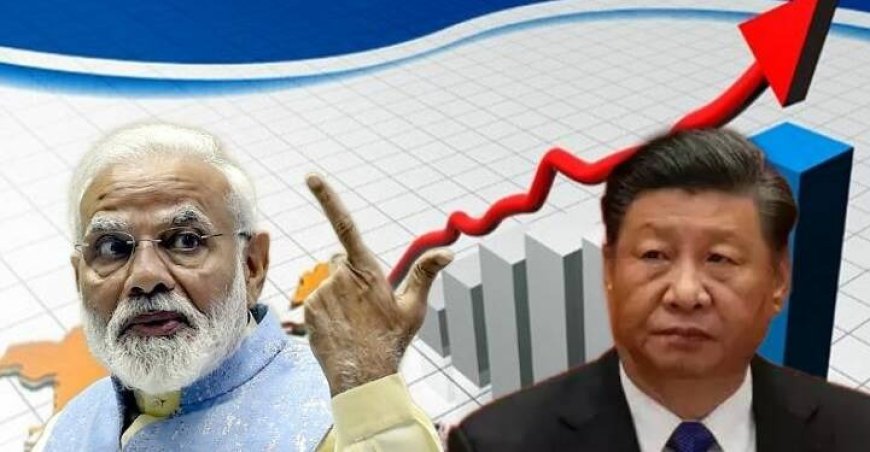Understanding the Growth Dynamics: A Comparative Analysis of the Indian and Chinese Economies
Explore the long-term economic outlook for China and India, including population trends, GDP growth differentials, and factors driving India's superior projections. Discover the shifting dynamics between these Asian behemoths.

The economies of India and China have been the center of attention in the global arena. With their large populations and vast economic potentials, these two countries have been on a rapid growth trajectory. In recent years, there has been a debate on whether the Indian economy is growing faster than China's. In this article, we will delve into the key indicators, analyze the growth patterns, and examine the factors contributing to the economic performance of both nations.
GDP Growth:
Gross Domestic Product (GDP) growth is one of the primary indicators used to measure economic performance. China has historically maintained a high GDP growth rate, fueled by its export-oriented manufacturing sector and massive infrastructure development. However, in recent years, India has shown signs of catching up, with a steadily increasing GDP growth rate. According to the World Bank, India's GDP growth rate was 7.5% in 2021, while China's was 8.1%. Although China's growth rate is slightly higher, India's growth rate is notable considering its population size and the challenges it faces.
Population and Market Size:
One of the key advantages of India is its large population, which translates into a massive consumer market. With over 1.4286 billion people, India offers a vast customer base for businesses and potential investors. China, with a population of over 1.4257 billion for China - 2.9 million fewer, also boasts a substantial market size. However, India's growing middle class and increasing purchasing power have attracted significant attention from global companies looking to tap into its consumer market.
Foreign Direct Investment (FDI):
Foreign Direct Investment plays a crucial role in driving economic growth. China has been a preferred destination for FDI due to its favorable business environment, infrastructure development, and manufacturing capabilities. However, India has been making significant strides in attracting foreign investments, particularly in sectors such as technology, e-commerce, and renewable energy. The Indian government's initiatives like "Make in India" and policy reforms have aimed to ease regulations and improve the ease of doing business, thus encouraging more FDI inflows.
Sectoral Analysis:
A closer look at the sectoral composition of both economies reveals distinct patterns. China has a strong manufacturing base and is known as the "factory of the world." Its manufacturing sector contributes significantly to its GDP growth. On the other hand, India has a more diversified economy, with services contributing a substantial share to its GDP. The Indian service sector, including IT services, finance, and telecommunications, has been a key driver of economic growth. Additionally, India has also witnessed growth in sectors like pharmaceuticals, e-commerce, and renewable energy.
Infrastructure Development:
China has invested heavily in infrastructure development, including high-speed railways, ports, and urban infrastructure. This has facilitated its manufacturing exports and boosted its domestic connectivity. In recent years, India has also been focusing on infrastructure development, with initiatives like the Bharatmala project for road connectivity, the Sagarmala project for port development, and the Smart Cities Mission. Enhancing infrastructure is crucial for attracting investments, improving logistics, and supporting sustainable economic growth.
Challenges and Reforms:
Both countries face their unique challenges. China's economic growth has been accompanied by issues such as environmental degradation, income inequality, and rising debt levels. The Chinese government has implemented various reforms to address these challenges and transition towards a more sustainable growth model. Similarly, India faces challenges such as bureaucratic hurdles, inadequate infrastructure, and labor market reforms. The Indian government has initiated several reforms like the Goods and Services Tax (GST), bankruptcy code, and liberalization of foreign investment policies to overcome these obstacles and promote inclusive growth.
A Comparative Outlook on China and India's Long-Term Economic Growth:
When examining the economic landscapes of China and India, China has undeniably held the spotlight as the more attractive prospect in recent decades. With a nominal GDP approximately six times larger than India's at USD 18 trillion, China's historical advantage in population size and higher real GDP growth rates has been notable.
However, the tables are poised to turn, at least in part, in the years ahead. According to IMF data, China's population is now on a decline. By 2027, China is projected to lose 8 million people, while India is anticipated to gain over 75 million, securing its position as the world's most populous country. Furthermore, India's real GDP growth is expected to outpace China's by over 2 percentage points annually throughout the forecast horizon.
Factors Driving India's Superior GDP Projections:
-
Favorable Demographics: India benefits from a relatively youthful and rapidly growing population, in stark contrast to China's aging and shrinking population. The demographic advantage provides a solid foundation for sustained economic growth and development.
-
Catch-up Growth Potential: India's lower income per capita compared to China offers significant potential for catch-up growth. With room for improvement in living standards and productivity, India can bridge the gap and accelerate its economic growth trajectory.
-
Dynamism of the Private Sector: China's dominance of state-owned firms may hinder the dynamism and innovation within its economy in the coming years. In contrast, India's vibrant private sector, driven by entrepreneurship and innovation, is expected to fuel sustained growth and provide a competitive edge.
-
Shifting International Landscape: China's growing international isolation, resulting from factors such as U.S. sanctions, strained relations with the West, and border restrictions, has prompted companies to diversify their supply chains away from the country. This trend is likely to continue, leading to a potential shift of manufacturing business from China to India. Notably, Apple's decision to begin production of the iPhone 14 in India exemplifies this evolving trend.
Contextualizing India's Economic Progress:
While India's GDP projections exceed China's growth rate, it is crucial to put this growth in perspective. Even by 2027, India's economy will remain around five times smaller than China's. India still faces challenges, such as dilapidated infrastructure, bureaucratic hurdles, and subpar educational standards, which may hinder its ability to surpass China as the world's factory in the near future. However, a partial economic convergence between the two powers appears likely in the coming years.
Conclusion: In conclusion, while China has maintained a higher GDP growth rate historically, India's economy has been gaining momentum and showing promising signs of growth. With its large consumer market, increasing FDI inflows, and a diversified economy, India has the potential to grow at a faster pace in the coming years. However, it is essential to address the challenges and continue implementing reforms to sustain this growth trajectory. As the two largest economies in Asia, the growth dynamics of India and China will significantly impact the global economy in the years to come.
Also Read: China Faces Mounting Pressure to Boost Economy Amidst Rate Cut Skepticism
































































